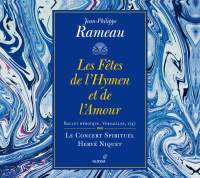Texte paru dans: / Appeared in:
*

International Record Review - (12//2014)
Pour
s'abonner / Subscription information
Glossa
GCD921629

Code-barres / Barcode : 8424562016293
(ID479)
Consultez toutes les évaluations recensées pour ce cd
~~~~ Reach all the evaluations located for this CD
Rameau and his librettist Louis de Cahusac adapted their ballet héroique Les Dieux d'Égypte to form an opera called Les Fêtes de l’Hymen et de l’Amour, which received its premiere on March 15th, 1747, at Versailles. Arias, duets, ensembles, choruses and dances fill the score. In the booklet, Thomas Soury writes that the opera ‘is possessed of tremendous qualities', adding that 'In this piece Rameau came up with some of the most marvellous musical creations.'
The work is divided into the Prologue and three entrées: 'Osiris', 'Canope' and 'Aruéris oo les Isies', each named after an Egyptian god, with Cahusac basing each section on Egyptian mythology, and in each entrée the relevant god falls in love, which is fitting, for the opera was written to celebrate the marriage of the Dauphin of France and Maria Josepha of Saxony. The Prologue finds Cupid very unhappy, for, as Bendit Dratwicki's synopsis states, 'the possibility of subjugating himself to the power of this formidable adversary is unacceptable to him', That adversary is Hymen, who arrives to see Cupid, with the result that all is well and the Graces, the Pleasures and the Virtues dance together.
The first entrée concerns Mirrine, an Amazon, dissuading Queen Orthésie from meeting Osiris. Mirrine tries to kill the god, but Ortbésie prevents it and admits that she loves Osiris, all ending with‑more rejoicing. In the second entrée the god Canope is disguised as Nilée, a young mortal who loves the nymph Memphis, who is about to be sacrificed to him in his godly form. He reveals his true identity and they declare their love for each other, again among festivities. Aruéris, god of the arts, has arranged a display of competitive games, named Les Isies after his mother Isis, in the third entrée. He loves another nymph, Orie, who sings in the competition and wins a crown of myrtle, which she dedicates to Cupid, after which Aruéris announces their marriage.
The various numbers are usually brief (only four exceed three minutes), and on the first CD, which runs for 54 minutes, are 40 tracks (14 are under a minute in duration). Again fittingly, as the opera is honouring a royal couple's wedding, the music has an overall gentleness. Even when Mirrine turns on Osiris there is nothing in the score to suggest violence or conflict and nothing compares with the grander music of Rameau's contemporary Handel, but much that is attractive will be found, and Rameau writes some beautifully varied orchestration, mainly in the dances, which elicits some stylish playing from Hervé Niquet's Le Concert Spirituel, the name covering both instrumentalists and chorus
In my review of Les
Bayadères by Catel (see page 82), I praised the singing of Chantal
Santon, whom I had never heard but I expressed a wish to hear her again. I
did not expect that a fortnight later I should be presented with another set
to consider, and here she is now listed as Santon‑Jeffery.
I am pleased to have the opportunity to isten to her again. Like every other
singer bar one in the cast of eight, she takes more than one role, appearing
as Orthésie in the first entrée and Osie in the third. It is in the latter
assignment that she has the longest aria in the work: 'Pour entendre ma
voix' ('I do so with much pleasure'). Her gleaming tone and smoothly flowing
emission are rewardingly dulcifying.
Two tenors, listed in the booklet as 'hautecontre', are involved. Neither has the sort of voice that 'one would hear in Italian verismo or even, I should think, in romantic roles in operas of Gounod, but they suit the roles that they undertake here. Mathias Vidal, who is also in Les Bayadères, produces a clean, focused sound, lightish when singing A Pleasure in the Prologue and tonally fuller as Aruéris, moving fluently through divisions and melismata. Reinoud Van Mechelen, whom I am hearing for the first time, has similar virtues: perhaps, but only perhaps, a touch sweeter tone than Vidal's. Both tenors fit the bill to a tee.
A more opulent sound is produced by Tassis Christoyannis, whose recital of songs by Félicien David I shall review in a future round‑up. His baritone brings a different colour and range from what has gone before, and the steadiness of his voice and its firmness suit Canope's anger at the planned sacrifice of Memphis and his ordering the people to drive out the priests who are ready to carry out the deed. As the High Priest, Alain Buet is sturdy in his few lines. Jennifer Borghi, the one participant with only one role, shows a touch of roughness as Mirrine, which could be assumed for this unappealing character. In her multiple casting as Hymen, the Egyptian Woman (the one who sings the aria at the end of the second entrée: there are other Egyptian women but their contributions are restricted to a few words) and the Egyptian Shepherdess, Blandine Staskiewicz eases out her highish mezzo to pleasing effect. Carolyn Sampson seems to be holding back somewhat, her Memphis suggesting a small voice. Niquet appears to strike sensible tempos (I have nothing to compare with this initial recording) and does not turn the opera into something on a bigger scale, and his orchestra does play well. The recorded sound is fine. The fact that only two days are listed persuades me to think that a couple of live performances were involved rather than time being spent on many re‑takes in a studio, but I hear no sign of an audience being present.
Cliquez l'un ou l'autre
bouton pour découvrir bien d'autres critiques de CD
Click either button for many other reviews


